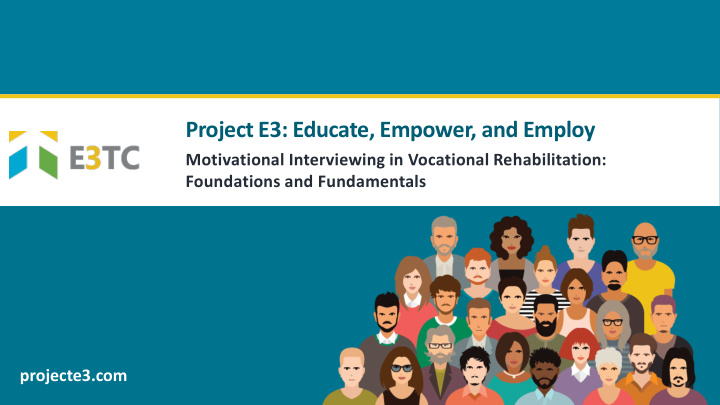



Project E3: Educate, Empower, and Employ Motivational Interviewing in Vocational Rehabilitation: Foundations and Fundamentals projecte3.com
Acknowledgement and Disclaimer ⇒ The contents of this presentation were developed with support from the Vocational Rehabilitation Technical Assistance Center for Targeted Communities (VR TAC TC: Project E3) at the Department of Rehabilitation and Disability Studies, Southern University, Baton Rouge, LA funded by the U.S. Department of Education, Rehabilitation Services Administration (Grant# H264F15003). ⇒ The ideas, opinions, and conclusions expressed, however, are those of the presenters and do not represent recommendations, endorsements, or policies of the U.S. Department of Education.
Motivational Interviewing in Vocational Rehabilitation: Foundations and Fundamentals Christopher C. Wagner, PhD, CRC, Lic. Clin.Psy. Virginia Commonwealth University College of Health Professions Department of Rehabilitation Counseling
Overview • What is motivation and how does it fit in VR? • What gets in the way of changing? • What is the essence of motivational interviewing (MI)? – Relationship/spirit – Communication methods – Establishing momentum toward change • The four processes of MI
Overview • What is motivation and how does it fit in VR? • What gets in the way of changing? • What is the essence of motivational interviewing (MI)? – Relationship/spirit – Communication methods – Establishing momentum toward change • The four processes of MI
What is motivation? Latin root – “movere”
Elements of Motivation
Intrinsic Motivation
What are some motivational elements involved in VR work?
Overview • What is motivation and how does it fit in VR? • What gets in the way of changing? • What is the essence of motivational interviewing (MI)? – Relationship/spirit – Communication methods – Establishing momentum toward change • The four processes of MI
What gets in the way of change? Doesn’t seem all that important • Enjoy current ways • It’s hard • Takes time to develop new habits • Reactance • Demoralized • Fear of failure • Ambivalence •
What is success in VR?
Obstacles to change in VR
Ambivalence
Signs of ambivalence Missed appointments • Poor hygiene/ inappropriate clothing • Problems with medication adherence • Dissatisfactions with (all) options • Disengagement, opposition, delaying, • defensiveness, passivity, hopelessness
Overview • What is motivation and how does it fit in VR? • What gets in the way of changing? • What is the essence of motivational interviewing (MI)? – Relationship/spirit – Communication methods – Establishing momentum toward change • The four processes of MI
Motivational Interviewing…
The Spirit of Motivational Interviewing
MI Communications
Closed Questions vs. Open Questions
Affirmations
Reflections Simple reflections – check/verify our understanding Complex reflections – make a guess at something beyond what the client says (feelings, values) Double-sided reflections – reflect both sides of ambivalence Metaphors – put dilemma into an image Reflection “with a twist” – reframe resistance into strength
Summaries
Change Talk (DARN-CAT)
Asking for Change Talk
Reflecting Change Talk
Overview • What is motivation and how does it fit in VR? • What gets in the way of changing? • What is the essence of motivational interviewing (MI)? – Relationship/spirit – Communication methods – Establishing momentum toward change • The four processes of MI
MI processes
MI processes
MI processes
MI processes
MI processes
MI processes
MI processes
MI processes
Planning 1. What specifically is the change you want to make? 2. What are the important reasons to make this change now? 3. What might get in the way? 4. Who could help you? 5. What’s the first step? 6. How will you know the plan is working?
Core MI strategy
Sponsors Vocational Rehabilitation Technical Assistance • Center for Targeted Communities (VR TAC TC: Project E3) at the Department of Rehabilitation and Disability Studies, Southern University, Baton Rouge, LA funded by the U.S. Department of Education, Rehabilitation Services Administration (Grant# H264F15003). VCU - Rehabilitation Research and Training Center • https://vcurrtc.org/index.cfm
Recommend
More recommend